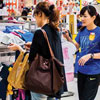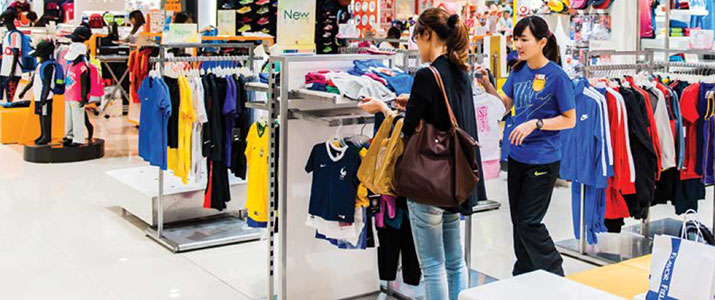
Putting an LP Spin on Video Analytics
Which analytics can give you a quick heads-up on potential loss activity?
- By Jackie Andersen
- Jun 01, 2014
 Video analytics aren’t just tools for marketing and merchandising;
these intelligent algorithms can also spot atypical customer behavior
that might suggest potential loss activity when viewed by the
Loss Prevention department.
Video analytics aren’t just tools for marketing and merchandising;
these intelligent algorithms can also spot atypical customer behavior
that might suggest potential loss activity when viewed by the
Loss Prevention department.
By looking at four of the common video analytics used by retailers
today, we can quickly see how departments can gain different business intelligence
from the same applications.
Heat Mapping: Seeing Where Shoppers Go
Heat mapping lets retailers visualize customer traffic patterns through the store
over time. This analytic uses color overlays to denote hot spots of activity and cold
spots with little or no foot traffic.
Marketing and merchandising departments have been using this information
for years to optimize store performance. They can see whether changing store layouts
or moving a new promotional display to a hotter location improves merchandise
performance. They can see where additional customer associates are needed
to assist customers on a busy sales floor.
The LP spin. When LP reviews a heat map, those cold and hot spots take on
a different meaning. Cold spots might indicate an area of the store where thieves
could more easily conceal items. Hot spots might indicate a potential flash mob,
especially if it suddenly comes out of nowhere with no underlying reasons for its
appearance, like a doorbuster promotion. Knowing that crimes of opportunity
often spike when there’s a lack of guardianship, an LP response to intelligence
gained from heat mapping would be to step up staffing in hot and cold areas.
From an LP perspective, heat mapping is especially useful in static environments
where the floor layout remains fairly constant. You can establish a good
baseline of activity that makes it easier to judge spikes and anomalies.
Take, for instance, a cosmetics counter. You might have make-up artists in the
aisles and sales associates behind the counter ringing up sales. But, if a popular
cosmetics brand is offering a free gift with purchase that day, you might get a sudden
influx of activity in the department. While the analytic might trigger an alert
to management to make sure that there is sufficient staff in the area to ring up
sales, LP will read the alert as a warning to beef up security and staffing to deter
customers from walking off with testers and products.
Choosing the right camera. When it comes to heat mapping analytics, you don’t
need a pricey, megapixel camera, as you’re only concerned about movement, not
image details. A cost-effective fixed or dome camera with a good lens, a decent
depth of field and either SVGA or 720p resolution would be sufficient for this application.
Though the typical orientation is horizontal, you might want to operate
the camera in corridor view for heat mapping long aisles.
Caveats. Because heat mapping relies on establishing a good baseline, it would
be a challenge to deploy this analytic in locations where the floor plan configuration
is constantly shifting. Without a reliable baseline, any comparative results
would be erroneous. Also, if the location experiences a wide range of lighting conditions
throughout the day—such as areas facing plate glass windows and doors—
you will need a camera that supports wide dynamic range to compensate for glare.
Dwell Time: Discovering Where Shoppers Linger
Dwell time lets retailers see which areas of the store catch a customer’s eye and
keep their attention. This analytic is designed to detect a person remaining stationary
in a particular location beyond a set period of time, a parameter designated
by the retailer. This application uses a graphic overlay on the video to pinpoint the
location where the dwell threshold has been exceeded.
From a marketing perspective, dwell time analytics can indicate if a display is
effective in attracting shopper interest. It can alert management to send a customer
service associate to the location to convert the browser to a buyer and perhaps
even upsell additional merchandise.
The LP spin. For LP, a dwell time alert can be a red flag that someone might be
looking for an opportunity to conceal a product or scoping out the location for
an organized retail theft sweep. In response, LP may simply send a store associate
to inquire if the person needs assistance. Once the individual realizes they’re being
observed, the window of opportunity for the concealment slams shut.
Consider a drugstore where shelves of baby formula might present a tempting
target for organized retail crime gangs. If dwell time analysis indicates someone or
several individuals are spending an inordinate amount of time comparing brands,
LP might view the alert as a warning for a potential sweep and take proactive steps
to avert it.
Choosing the right camera. When it comes to dwell time analytics, most retailers
use fixed-dome cameras mainly because they provide the right depth-of-field and
angle for good situational awareness. Plus, their unobtrusive design blends in well
with a retail environment. If the camera is being used solely for dwell time analysis,
SVGA or 720p resolution would be sufficient. But, if you’re using the camera
for multiple purposes, you might want to choose a 1080p camera to capture facial
details.
Caveat. LP will face additional challenges as organized retail crime becomes
more sophisticated and incidents happen even faster. As with heat mapping, if the
location experiences a wide range of lighting conditions throughout the day, you
would need a camera that supports wide dynamic range to compensate for glare.
People Counting: Tallying Customer Traffic
People counting lets retailers keep track of how many shoppers are entering the
store. This algorithm is designed traditionally to be one-directional so that it
doesn’t count people leaving the premises. The information is generally presented
in a graph broken down into units of time.
Retailers most often use people counting to calculate conversion rates and predict
peak times when more staff is needed as traffic ebbs and flows. By aggregating
this information over time, management can compare their store sales with other
store’s—the Holy Grail of retailing.
The LP spin. When LP studies people-counting statistics, they’re looking to find
a correlation between customer density and returns. By familiarizing themselves with the baseline—the average density
of shoppers from sales to returns—they
can spot anomalies that might indicate
fraudulent rather than honest returns.
For instance, if LP discovers that
the highest rate of return is occurring
one or two hours before closing, they
would likely conclude that these transactions
bear further scrutiny. It could
be that dishonest patrons are looking
for times when staff is busy restocking
shelves and closing down the store,
making them too distracted to review
return receipts carefully. Or, it could
be that with few customers at the end
of the day, an employee might be doing
their own fraudulent returns. Upon
further investigation, LP could discover
tell-tale signs, like the absence of a
customer and an associated credit card
receipt linked to the original purchase.
In some retail establishments that operate
stores within stores, management
might install secondary people-counting
cameras just to measure traffic to luxury
specialty or high ticket item areas. For
marketing and merchandising, it would
be a way to calculate conversion rates
and profitability of those locations separate
from the overall performance of the
store. But for LP, seeing unusual spikes
in head count in those areas with highervalue
merchandise might set off warning
bells. This would be especially true if
the secondary people-counting cameras
were strategically deployed in a distribution
center where high-end inventory,
like expensive jewelry and accessories,
were stored.
Choosing the right camera. A fixed
dome would mostly likely be your go-to
camera for people counting. Depending
on the size of the area being covered
and the type of detail you need
to capture, you’re probably fine with
a standard SVGA image. You could,
however, bump all the way up to a five
megapixel camera if you’re using the
video for other situational awareness.
Caveat. It’s important to establish
a baseline for typical customer traffic
at different times of the day so that
you can set alerts for deviations. You
need to recognize that many peoplecounting
analytics are self-learned
and become more accurate over time.
With continuous usage, they become
smarter at discerning between human
and non-human images, such as guide
dogs, shopping carts and strollers, so
occasionally recalibrate your baseline
to ensure it reflects actual traffic into
the store.
Facial Cataloging:
Identifying Types of Shoppers
Facial cataloging is one of the new analytics
gaining attention and traction in
retail. This algorithm is designed to deduce
the gender and approximate age
of shoppers based on facial geometry.
It can also predict general mood by
analyzing facial expressions.
Marketing and merchandising departments
often use facial cataloging
in conjunction with smart monitors
scattered throughout the floor. Once
the video analytic determines the demographic
of the individual in the vicinity of the monitor, the screen begins
to stream content that might appeal to
that gender and age group.
For instance, if facial cataloging
identifies the shopper as a female
between the ages of 40 and 50, the
screen might display advertisements
for wrinkle cream or accessories to
complement the newest ready-to-wear
apparel. If the shopper was recognized
as a male, the promotional content
might be for grooming tools or the
latest men’s sportswear. The goal is to
upsell the customer on additional purchases
wherever the opportunity presents
itself.
Facial cataloging can be used to alert
management of the presence of VIP
customers in the store so that personal
shoppers can be dispatched to assist
these customers with their purchases.
The LP spin. Facial cataloging helps
LP quickly spot repetitive criminal behaviors
by re-offenders or known retail
crime members as they enter the premises
by sending an alert to staff, who
can then respond according to store
policy and local laws. The reference facial
database might include links to local
law enforcement or other retailers’
watch lists.
In addition to identifying known
suspects, LP can use facial cataloging
to thwart internal theft. For example, if
an associate repeatedly shows up in a
high-ticket area of the store that is not
part of their usual assigned territory,
especially with no customer in tow,
then that sends up a red flag for LP to
further investigate the situation.
Choosing the right camera. When
it comes to facial cataloging, you need
a megapixel camera to capture enough
facial details for identification. The
camera has to be mounted with no more
than a 9 degree slope or you’ll end up
with hair follicle recognition instead.
Depending on the lighting levels, you
may need a camera with wide dynamic
range or lowlight technology to deliver
usable images, especially in dynamicallychanging
lighting conditions. Another
thing to keep in mind is that cameras
used for facial cataloging should only be
used for that single purpose.
Caveat. The biggest roadblock to
implementing facial cataloging is privacy
rights, which are regulated on a
state-by-state basis.
In the beginning, video analytics
were primarily used for marketing
and merchandising, but as these algorithms
integrate into standard operating
procedures, their cross-functional
value is becoming even more apparent.
When LP applies this intelligence to
its surveillance toolbox, the ability to
anticipate and avert loss increases significantly,
as does the retailer’s overall
return on investment.
This article originally appeared in the June 2014 issue of Security Today.